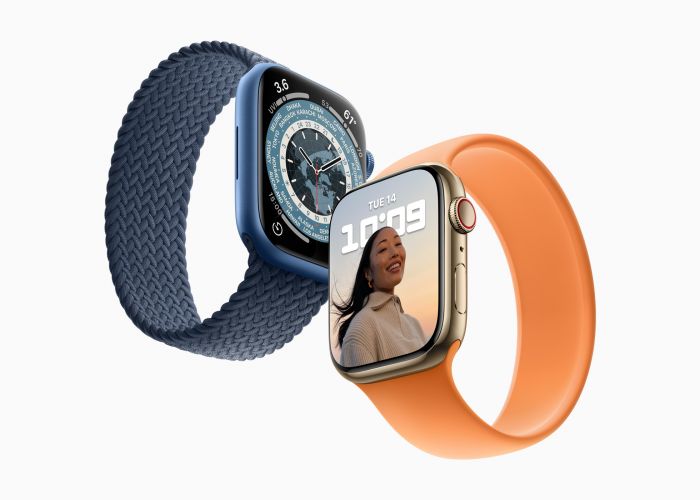
Apple recently launched the latest iteration of its smartwatch – the Series 7. The standout new features are a bigger, better, more durable screen, speedier charging, and a lower entry price versus the Series 6 last year. These tweaks keep Apple’s primacy in the smartwatch market.
Pricing
The Series 7 version costs from £369/$399. In comparison, last year’s Series 6 was £10 more expensive at launch. Notwithstanding the lower starting price point, the Series 7 remains Apple’s most expensive smartwatch in Apple’s current roster, which includes the Watch SE, costing from £249/$279, and the Series 3 (£179/$199). It requires an iPhone 6S or above, and is not compatible with Android.
Size
The Series 7 is available in 41 or 45mm case sizes, both 1mm taller than their predecessors. This height increase, combined with noticeably thinner bezels, mean the screens are 20% larger. On a device as small as a smartwatch, where every extra pixel matters, this represents a significant size increase. The advantages of increased screen real estate are manifold: more text fits on the display, fonts can be enlarged and easier to read, and buttons are bigger and therefore easier to tap. Moreover, new watch faces, such as the Modular Duo, can contain two full-size information widgets simultaneously, and there’s a new full qwerty keyboard for typing messages – a feature exclusive to the Series 7.
Performance and Battery Life
In terms of charging times, the Series 7 will reach 50% in about half an hour, and full in 70 minutes using the new, faster USB-C charging puck (power adaptor not included). It can still charge from the older USB-A charging pucks but at a slower rate.
The new S7 chip equals the performance of last year’s S6, making the Series 7 the quickest and slickest smartwatch available today. Battery life is similar, too, lasting about 36 hours between charges with sleep tracking overnight and the screen on throughout the day. Tracking my 60-minute elliptical workout consumed 10% of the battery, so endurance athletes can be confident that the watch will see them through a triathlon or two.

WatchOS 8 and health tracking
In common with every Apple Watch from 2015’s Series 3, the Series 7 runs the same watchOS 8 software. Enhancements include a portrait photo watch face, the “focus” notification handlings from iOS 15 and the ability to set multiples timers simultaneously. Furthermore, the Apple Watch can also now be used to unlock an iPhone with Face ID when wearing a mask, which is extremely useful as covid measures persist in many jurisdictions.
Another improvement is better text entry, including the ability to use combinations of dictation, emojis, scribble, and a full qwerty keyboard. There is also a revamped meditation app that blends breathing coaching with mindfulness.
WatchOS 8 is the best supported and most adept smartwatch operating system available, in spite of recent advances by Google with WearOS. Users can look forward to five years or more of software support, including feature and security updates, which means the longevity of the watch is far greater than smartwatch competitors.
The Series 7 is equipped with the same comprehensive health-monitoring features as the Series 6, including one of the most accurate wrist-worn heart rate sensors available, along with blood oxygen level monitoring and fitness tracking across a large range of workout types. Only dedicated multisport watches can track more metrics across running, cycling, and adventure sports. Sleep tracking now includes respiration rate, although still doesn’t provide data on sleep cycles like some competitors.
Sustainability
The Series 7 uses 100% recycled aluminium, 99% recycled tungsten and rare earth elements, and 100% recycled tin in the solder of its main chips. Apple offers trade-in and complimentary recycling for devices, and bands made for older Apple Watch models fit the Series 7.
Whilst Apple does not provide an anticipated lifespan for the battery in the Series 7, batteries in similar devices typically last at least 500 full charge cycles whilst maintaining at least 80% of their original capacity. The battery can be replaced for around £80. Repairs cost between £285/$385 and £460/$645 depending on the model.

Price
The Apple Watch Series 7 comes in two sizes, three different materials and models with the option of 4G that requires an eSIM and compatible phone plan add-on.
The aluminium or Nike Versions in 41mm size cost £369/$399/A$599 or £399/$429/A$649, respectively. 4G models cost an extra £100/$100/A$150. Stainless steel and titanium models are more expensive.
Conclusion
The Series 6 set a high bar, so the main improvements introduced to the Series 7 – faster charging and a bigger, better screen – enhance an already excellent product.
It is expensive, but the top-class health features, excellent haptic vibrations, always-on screen, 50m water resistance, activity tracking, and long software support justify the price.
If you have a Series 6, it is probably not worth upgrading this year. For those with older models, or iPhone users investing in their first smartwatch, however, the Apple Watch Series 7 is unbeatable.
Specifications
Case size: 41 or 45mm Case thickness: 10.7mm Weight: 32/38.8g, 42.3/51.5g or 37/45.1g depending on material and size Processor: S7 RAM: 1GB Storage: 32GB Operating system: WatchOS 8 Water resistance: 50 metres (5ATM) Sensors: gyro, HR, ECG, blood oxygen, microphone, speaker, NFC, GNSS, compass, altimeter Connectivity: Bluetooth 5, wifi n, NFC, ultra wideband, optional 4G/eSIM
To configure your watch, and to purchase, please visit apple.com/













